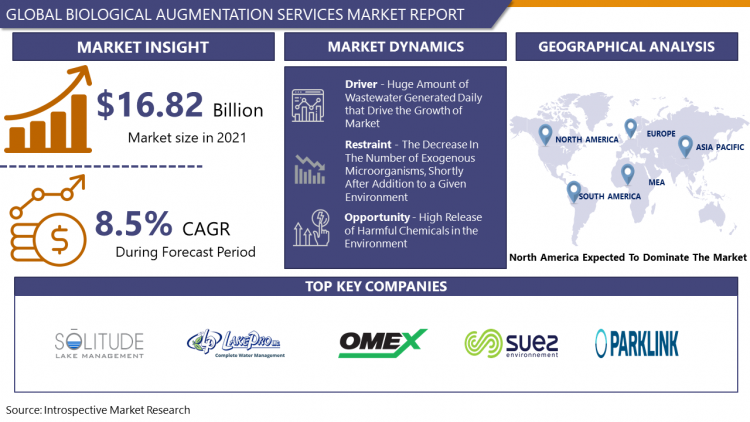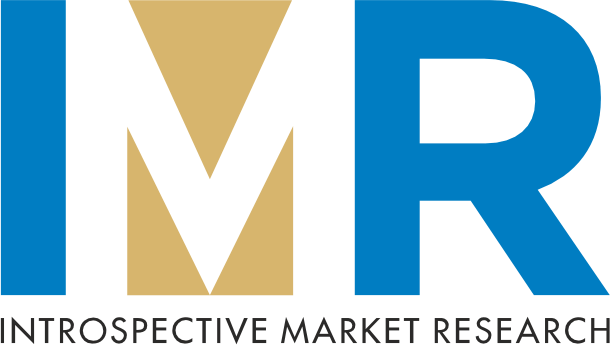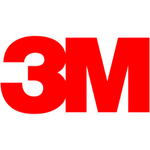Global Biological Augmentation Services Market Overview
The Global Biological Augmentation Services Market size is expected to grow from USD 18.25 Billion in 2022 to USD 35.05 Billion by 2030, at a CAGR of 8.5% during the forecast period (2023-2030).
Biological augmentation is the integration of modern technology and living microorganisms for the degradation of pollutants in contaminated sites. Biological augmentation is the utilization of specific micro-organisms which have unique characteristics that are employed in contaminated locations to eliminate the target pollutants. Moreover, Bioaugmentation technology has various applications and can be administered in all the wastewater treatment plants that are utilizing the activated sludge treatment process, irrespectively of their layout and configuration. Furthermore, Bioaugmentation is an eco-friendly and economically favorable method for improved degradation of pollutants and pathogens by the addition of pre-grown microbe or microbial cocultures in the medium. Biological augmentation services are a promising alternative procedure to remediate chlorinated ethene-contaminated groundwater as compared to physicochemical methods. Among the available biological methods to treat polluted soil and water, bioaugmentation is the most widely preferred technology for the decomposition of inorganic or organic pollutants and their residues from the environment. In addition, biological augmentation services are the green technologies that have shown promising results in decomposing contaminants from soil and water. With the growing industrial usage of water and the rising demand for eco-friendly technologies to disinfect contaminated locations, governments are incorporating biological augmentation services to disinfect water and make it reusable for industries and other purposes.

Market Dynamics and Factors in Biological Augmentation Services Market:
Drivers:
A promising durable and sustainable solution to the rising scarcity of water worldwide is to recycle and reuse wastewater. In wastewater treatment plants, the biodegradation of contaminants or pollutants by exploiting microorganisms present in activated sludge is the most important technique to eliminate organic contaminants found in wastewater. The traditional Physico-chemical treatment methods include several processes and the overall cost involved is not feasible. In addition, the byproducts generated by this process are toxic to the environment thus, treatment of wastewater through biological augmentation services is economically favorable and environmentally friendlier. Moreover, naturally occurring microorganisms are present in activated sludge that can decompose a wide range of pollutants, but some pollutants are resistant to this degradation process. Bioaugmentation services can tackle these challenges, as one of its main benefits is that treatment of contaminated sites can be tailored to a specific pollutant that is predominant in the environment. Thus, this method is attractive for tackling both the rising number of emerging pollutants as well as pollutants that are present at high concentrations in a given location.
Furthermore, the pulp and paper industry generates a huge amount of wastewater which is high in lignin concentration, known as black liquor. In addition, the selection and addition of lignin decomposing microorganisms into wastewater aids in removing specific pollutants originating from black liquor. Moreover, bioaugmentation of polluted water increases the clarity of the water. In addition, it reduces the concentration of ammonia, nitrite, and phosphate. Bioaugmentation of polluted water also removes the excess nutrients and noxious odors. Bioaugmentation technology can effectively remove target pollutants, accelerate system startup, improve the system's ability to resist hydraulic and organic loads, and enhance the stability of system flora structure and function.
Restraints:
The decrease in the number of exogenous microorganisms, shortly after addition to a given environment is a vital concern while employing bioaugmentation services. In addition, the gradual decrease in the number of microorganisms can be attributed to both biotic and abiotic stress. Moreover, the stresses occur due to insufficient substrates, temperature changes, competition between introduced and indigenous microorganisms, pH, nutrient limitations, phase infections, the shock of pollutant load, grazing by protozoa, and factors associated with quorum sensing (QS), thus, hampering the growth of biological augmentation services market during the forecast period.
The inoculum size is an essential factor for successful bioaugmentation. If the density of inoculum is low then there is a higher possibility of protozoan grazing. Protozoan grazing or growth of protozoan destroys the inoculated bacteria thus, affecting the functioning of the microorganism responsible for the degradation of pollutants. Moreover, the most successful cases of bioaugmentation are demonstrated in confined systems, such as bioreactors in which the environmental factors can be controlled to favor survival and prolonged activity of the exogenous microbial population, this limitation of biological augmentation services restricts the expansion of the market in the forecast period.
Opportunities:
The growing wastewater production and the release of harmful chemicals in the environment are the concerning factors that restrict the development of several industrial verticals. Moreover, the ever-growing requirement of freshwater for public and industrial usage is compelling governments to find alternative methods to treat wastewater. Immobilization (entrapment or encapsulation) of microorganisms in the process that consists of entrapping live microorganisms within a semi-permeable gel or carrier materials, which offers several benefits over the free cell bioaugmentation. Additionally, it can also protect inoculated microorganisms against protozoa grazing and bacteriophage infections. Recent studies have shown that immobilization of microorganisms improves biological and physical stabilities, by decreasing challenges such as sudden and brief variations of temperature or pH and protecting from abiotic stresses such as the inhibitory effect of toxic compounds or heavy metals thus, market players can develop novel techniques to enhance immobilization process. Moreover, the growing investment by governments in research activities of biotechnological processes to develop novel technologies to tackle wastewater generated by several industries is offering lucrative opportunities for the market players. The modulation of quorum sensing to increase the formation of biofilms could also contribute to the improvement of bioaugmentation for wastewater treatment. The administration of genetically modified microorganisms (GMM) is another novel technique to improve bioaugmentation, thus stimulating market players to collaborate with research institutes to develop novel strains of bacteria that can be utilized in bioaugmentation services.
Market Segmentation
Segmentation of Biological Augmentation Services Market:
Depending on the type of microorganism, the bacteria segment is forecasted to have the highest share of the biological augmentation services market. The presence of a wide range of bacterial strains and their capability to thrive in harsh environmental conditions make them the most preferred option for the wastewater treatment process. Moreover, bacteria are the predominant biological composition present in activated sludge and play a vital role in the structural and functional performance of flocs. Furthermore, genetically modified bacteria can decompose heavy metals from cosmetics, pharmaceutical, and detergents industries. Acknowledging the wide usage of bacteria in the treatment of pollutants the demand for genetically modified bacterial species is going to rise in the forecast period.
Depending on usage, the water segment is anticipated to dominate the biological augmentation services market during the forecast period. Water plays an important role in several industrial processes. Moreover, the rise in wastewater production from industrial verticals and the presence of toxic pollutants are driving the need to decompose the contaminants. The accumulation of pollutants in groundwater and the growing scarcity of water has forced governments to make wastewater potable for drinking through bioaugmentation services thus, supporting the development of this segment.
Depending on applications, the municipal segment is expected to lead the biological augmentation services market in the forecast period. Municipal corporations play an important role in supplying fresh water for both public and industrial purposes. Moreover, the growing number of governments regulated sewage water treatment plants, and the rising fundings to enhance the functionality of these plants is consolidating the growth of this segment.
Players Covered in Biological Augmentation Services market are :
- Black Lagoon (US)
- SOLitude Lake Management (US)
- LakePro Inc. (US)
- OMEX (UK)
- RF WasteWater (US)
- SUEZ (France)
- Aquatic Biologists Inc. (the US)
- Parklink Limited (New Zealand)
- WET USA (US)
- Barber's Chemicals (US)
- Skyhawk Global (UK)
- Kurita Water Industries Ltd. (Japan)
- Acti-Zyme Products Ltd. (Canada)
- Aquatic Plus Pond Management LLC (US)
- Oxybeesolutions (India)
- Enva (Ireland)
Regional Analysis of Biological Augmentation Services Market:
The North American region is anticipated to dominate the bioaugmentation services market during the forecast period. The USA and Canada are the major economies contributing to the expansion of the market in this region. Moreover, in the USA, drinking water and wastewater systems account for 3-4% of energy usage and emit more than 45 million tons of Greenhouse gases a year. In addition, the most common pollutant of groundwater in the USA is gasoline. There are thousands of steel tanks discharging gas into the soil beneath old gas stations attributed to the corrosion of drums. Additionally, the government is employing bioaugmentation services to clean up the contaminated soil rather than implementing the expensive, labor-intensive process of manual cleanup. Furthermore, the U.S. Department of Energy is even investigating the advantages of utilizing microbes, or genetically modified strains of known microbes, to clean up radiation from sites leftover from the production of nuclear weapons thus, strengthening the expansion of the market in this region.
Asia-Pacific region is forecasted to grow at the highest growth rate, attributed to the rise in the production of sewage water. Moreover, the growing technological advancements in the field of biotechnology have stimulated the government to adopt ecofriendly methods to decompose the harmful toxins present in sewage water. China, India, Japan, Singapore, and Australia are the major countries that have adopted the usage of biological augmentation services at a large scale. Singapore is the prominent country in this region, which has adapted to the 'toilet to tap' concept. The country filters toilet water through bioaugmentation technology and makes it reusable for industrial and drinking purposes. The depleting groundwater sources in India has forced the government to utilize the potential of bioaugmentation services, thus accelerating the development of the market in this region.
The European region is expected to have a significant growth rate in the forecasted timespan. The countries in this region are striving to eliminate toxins found in the wastewater. Moreover, the supportive government policies and the rise in the fundings for the implementation of bioaugmentation services to treat contaminated water and soil are the main factors fueling the expansion of the market in this region.
The Middle-East and Africa region is predicted to have a positive growth rate over the projection period. The scarcity of water in this region has forced the governments to invest in research activities to make wastewater potable for drinking. Moreover, the funding by philanthropists to provide drinkable water for the population residing in this region is boosting the development of the market in this region.
Key Industry Developments in Biological Augmentation Services Market:
- In May 2021, Parklink Limited declared the results of the new product Qwik-Zyme P, in degrading the proteins found in the dairy wastewater. The testing showed an 88% improvement in protein breakdown versus control in the hydrolysis, while both lab and field samples used in oxygen uptake testing presented increased rates of degradation.
- In November 2021, Kurita Water Industries Ltd. announced that it has developed a novel technique and has started applying the Power Bio E-PLUS™, for purifying soil contaminated with volatile organic compounds (VOCs), that are present in soil and groundwater, without soil excavation.
- In January 2019, Enva, a prominent provider of water, recycling and resource recovery services in the UK and Ireland, has declared the acquisition of Bio Industries Limited. With this collaboration Enva will be able to utilize tailored, high-quality environment products and solutions to treat wastewater, utilities, food manufacturing, and processing and aquaculture industries.
COVID-19 Impact on Biological Augmentation Services Market:
The outbreak of COVID-19 severely affected the operational activities of several industries. Moreover, the biotechnology sector was under pressure to develop vaccines for restricting the spread of the disease. The restriction imposed on the exports and imports of goods resulted in a shortage of equipment required for the installation of wastewater treatment facilities. Furthermore, governments were compelled to divert the fundings allotted to the installation of new utilities to the healthcare sector. Bioaugmentation services were high in demand pre-pandemic situations and are forecasted to have the same demand post-pandemic.
|
Global Biological Augmentation Services Market |
|||
|
Base Year: |
2022 |
Forecast Period: |
2023-2030 |
|
Historical Data: |
2017 to 2030 |
Market Size in 2022: |
USD18.25 Bn. |
|
Forecast Period 2023-30 CAGR: |
8.5% |
Market Size in 2030: |
USD 235.05 Bn. |
|
Segments Covered: |
By Type |
|
|
|
By Application |
|
||
|
By Usage |
|
||
|
By Region |
|
||
|
Key Market Drivers: |
|
||
|
Key Market Restraints: |
|
||
|
Key Opportunities: |
|
||
|
Companies Covered in the report: |
|
||
Chapter 1: Introduction
1.1 Research Objectives
1.2 Research Methodology
1.3 Research Process
1.4 Scope and Coverage
1.4.1 Market Definition
1.4.2 Key Questions Answered
1.5 Market Segmentation
Chapter 2:Executive Summary
Chapter 3:Growth Opportunities By Segment
3.1 By Type
3.2 By Application
3.3 By Usage
Chapter 4: Market Landscape
4.1 Porter's Five Forces Analysis
4.1.1 Bargaining Power of Supplier
4.1.2 Threat of New Entrants
4.1.3 Threat of Substitutes
4.1.4 Competitive Rivalry
4.1.5 Bargaining Power Among Buyers
4.2 Industry Value Chain Analysis
4.3 Market Dynamics
4.3.1 Drivers
4.3.2 Restraints
4.3.3 Opportunities
4.5.4 Challenges
4.4 Pestle Analysis
4.5 Technological Roadmap
4.6 Regulatory Landscape
4.7 SWOT Analysis
4.8 Price Trend Analysis
4.9 Patent Analysis
4.10 Analysis of the Impact of Covid-19
4.10.1 Impact on the Overall Market
4.10.2 Impact on the Supply Chain
4.10.3 Impact on the Key Manufacturers
4.10.4 Impact on the Pricing
Chapter 5: Biological Augmentation Services Market by Type
5.1 Biological Augmentation Services Market Overview Snapshot and Growth Engine
5.2 Biological Augmentation Services Market Overview
5.3 Archaea
5.3.1 Introduction and Market Overview
5.3.2 Historic and Forecasted Market Size (2016-2028F)
5.3.3 Key Market Trends, Growth Factors and Opportunities
5.3.4 Archaea: Grographic Segmentation
5.4 Bacteria
5.4.1 Introduction and Market Overview
5.4.2 Historic and Forecasted Market Size (2016-2028F)
5.4.3 Key Market Trends, Growth Factors and Opportunities
5.4.4 Bacteria: Grographic Segmentation
5.5 Fungi
5.5.1 Introduction and Market Overview
5.5.2 Historic and Forecasted Market Size (2016-2028F)
5.5.3 Key Market Trends, Growth Factors and Opportunities
5.5.4 Fungi: Grographic Segmentation
Chapter 6: Biological Augmentation Services Market by Application
6.1 Biological Augmentation Services Market Overview Snapshot and Growth Engine
6.2 Biological Augmentation Services Market Overview
6.3 Industrial
6.3.1 Introduction and Market Overview
6.3.2 Historic and Forecasted Market Size (2016-2028F)
6.3.3 Key Market Trends, Growth Factors and Opportunities
6.3.4 Industrial: Grographic Segmentation
6.4 Agriculture
6.4.1 Introduction and Market Overview
6.4.2 Historic and Forecasted Market Size (2016-2028F)
6.4.3 Key Market Trends, Growth Factors and Opportunities
6.4.4 Agriculture: Grographic Segmentation
6.5 Municipal
6.5.1 Introduction and Market Overview
6.5.2 Historic and Forecasted Market Size (2016-2028F)
6.5.3 Key Market Trends, Growth Factors and Opportunities
6.5.4 Municipal: Grographic Segmentation
Chapter 7: Biological Augmentation Services Market by Usage
7.1 Biological Augmentation Services Market Overview Snapshot and Growth Engine
7.2 Biological Augmentation Services Market Overview
7.3 Water
7.3.1 Introduction and Market Overview
7.3.2 Historic and Forecasted Market Size (2016-2028F)
7.3.3 Key Market Trends, Growth Factors and Opportunities
7.3.4 Water: Grographic Segmentation
7.4 Soil
7.4.1 Introduction and Market Overview
7.4.2 Historic and Forecasted Market Size (2016-2028F)
7.4.3 Key Market Trends, Growth Factors and Opportunities
7.4.4 Soil: Grographic Segmentation
Chapter 8: Company Profiles and Competitive Analysis
8.1 Competitive Landscape
8.1.1 Competitive Positioning
8.1.2 Biological Augmentation Services Sales and Market Share By Players
8.1.3 Industry BCG Matrix
8.1.4 Ansoff Matrix
8.1.5 Biological Augmentation Services Industry Concentration Ratio (CR5 and HHI)
8.1.6 Top 5 Biological Augmentation Services Players Market Share
8.1.7 Mergers and Acquisitions
8.1.8 Business Strategies By Top Players
8.2 BLACK LAGOON
8.2.1 Company Overview
8.2.2 Key Executives
8.2.3 Company Snapshot
8.2.4 Operating Business Segments
8.2.5 Product Portfolio
8.2.6 Business Performance
8.2.7 Key Strategic Moves and Recent Developments
8.2.8 SWOT Analysis
8.3 SOLITUDE LAKE MANAGEMENT
8.4 LAKEPRO INC.
8.5 OMEX
8.6 RF WASTEWATER
8.7 SUEZ
8.8 AQUATIC BIOLOGISTS INC.
8.9 PARKLINK LIMITED
8.10 WET USA
8.11 BARBER'S CHEMICALS
8.12 SKYHAWK GLOBAL
8.13 KURITA WATER INDUSTRIES LTD.
8.14 ACTI-ZYME PRODUCTS LTD.
8.15 AQUATIC PLUS POND MANAGEMENT LLC
8.16 OXYBEESOLUTIONS
8.17 ENVA
8.18 OTHER MAJOR PLAYERS
Chapter 9: Global Biological Augmentation Services Market Analysis, Insights and Forecast, 2016-2028
9.1 Market Overview
9.2 Historic and Forecasted Market Size By Type
9.2.1 Archaea
9.2.2 Bacteria
9.2.3 Fungi
9.3 Historic and Forecasted Market Size By Application
9.3.1 Industrial
9.3.2 Agriculture
9.3.3 Municipal
9.4 Historic and Forecasted Market Size By Usage
9.4.1 Water
9.4.2 Soil
Chapter 10: North America Biological Augmentation Services Market Analysis, Insights and Forecast, 2016-2028
10.1 Key Market Trends, Growth Factors and Opportunities
10.2 Impact of Covid-19
10.3 Key Players
10.4 Key Market Trends, Growth Factors and Opportunities
10.4 Historic and Forecasted Market Size By Type
10.4.1 Archaea
10.4.2 Bacteria
10.4.3 Fungi
10.5 Historic and Forecasted Market Size By Application
10.5.1 Industrial
10.5.2 Agriculture
10.5.3 Municipal
10.6 Historic and Forecasted Market Size By Usage
10.6.1 Water
10.6.2 Soil
10.7 Historic and Forecast Market Size by Country
10.7.1 U.S.
10.7.2 Canada
10.7.3 Mexico
Chapter 11: Europe Biological Augmentation Services Market Analysis, Insights and Forecast, 2016-2028
11.1 Key Market Trends, Growth Factors and Opportunities
11.2 Impact of Covid-19
11.3 Key Players
11.4 Key Market Trends, Growth Factors and Opportunities
11.4 Historic and Forecasted Market Size By Type
11.4.1 Archaea
11.4.2 Bacteria
11.4.3 Fungi
11.5 Historic and Forecasted Market Size By Application
11.5.1 Industrial
11.5.2 Agriculture
11.5.3 Municipal
11.6 Historic and Forecasted Market Size By Usage
11.6.1 Water
11.6.2 Soil
11.7 Historic and Forecast Market Size by Country
11.7.1 Germany
11.7.2 U.K.
11.7.3 France
11.7.4 Italy
11.7.5 Russia
11.7.6 Spain
11.7.7 Rest of Europe
Chapter 12: Asia-Pacific Biological Augmentation Services Market Analysis, Insights and Forecast, 2016-2028
12.1 Key Market Trends, Growth Factors and Opportunities
12.2 Impact of Covid-19
12.3 Key Players
12.4 Key Market Trends, Growth Factors and Opportunities
12.4 Historic and Forecasted Market Size By Type
12.4.1 Archaea
12.4.2 Bacteria
12.4.3 Fungi
12.5 Historic and Forecasted Market Size By Application
12.5.1 Industrial
12.5.2 Agriculture
12.5.3 Municipal
12.6 Historic and Forecasted Market Size By Usage
12.6.1 Water
12.6.2 Soil
12.7 Historic and Forecast Market Size by Country
12.7.1 China
12.7.2 India
12.7.3 Japan
12.7.4 Singapore
12.7.5 Australia
12.7.6 New Zealand
12.7.7 Rest of APAC
Chapter 13: Middle East & Africa Biological Augmentation Services Market Analysis, Insights and Forecast, 2016-2028
13.1 Key Market Trends, Growth Factors and Opportunities
13.2 Impact of Covid-19
13.3 Key Players
13.4 Key Market Trends, Growth Factors and Opportunities
13.4 Historic and Forecasted Market Size By Type
13.4.1 Archaea
13.4.2 Bacteria
13.4.3 Fungi
13.5 Historic and Forecasted Market Size By Application
13.5.1 Industrial
13.5.2 Agriculture
13.5.3 Municipal
13.6 Historic and Forecasted Market Size By Usage
13.6.1 Water
13.6.2 Soil
13.7 Historic and Forecast Market Size by Country
13.7.1 Turkey
13.7.2 Saudi Arabia
13.7.3 Iran
13.7.4 UAE
13.7.5 Africa
13.7.6 Rest of MEA
Chapter 14: South America Biological Augmentation Services Market Analysis, Insights and Forecast, 2016-2028
14.1 Key Market Trends, Growth Factors and Opportunities
14.2 Impact of Covid-19
14.3 Key Players
14.4 Key Market Trends, Growth Factors and Opportunities
14.4 Historic and Forecasted Market Size By Type
14.4.1 Archaea
14.4.2 Bacteria
14.4.3 Fungi
14.5 Historic and Forecasted Market Size By Application
14.5.1 Industrial
14.5.2 Agriculture
14.5.3 Municipal
14.6 Historic and Forecasted Market Size By Usage
14.6.1 Water
14.6.2 Soil
14.7 Historic and Forecast Market Size by Country
14.7.1 Brazil
14.7.2 Argentina
14.7.3 Rest of SA
Chapter 15 Investment Analysis
Chapter 16 Analyst Viewpoint and Conclusion
|
Global Biological Augmentation Services Market |
|||
|
Base Year: |
2022 |
Forecast Period: |
2023-2030 |
|
Historical Data: |
2017 to 2030 |
Market Size in 2022: |
USD18.25 Bn. |
|
Forecast Period 2023-30 CAGR: |
8.5% |
Market Size in 2030: |
USD 235.05 Bn. |
|
Segments Covered: |
By Type |
|
|
|
By Application |
|
||
|
By Usage |
|
||
|
By Region |
|
||
|
Key Market Drivers: |
|
||
|
Key Market Restraints: |
|
||
|
Key Opportunities: |
|
||
|
Companies Covered in the report: |
|
||
LIST OF TABLES
TABLE 001. EXECUTIVE SUMMARY
TABLE 002. BIOLOGICAL AUGMENTATION SERVICES MARKET BARGAINING POWER OF SUPPLIERS
TABLE 003. BIOLOGICAL AUGMENTATION SERVICES MARKET BARGAINING POWER OF CUSTOMERS
TABLE 004. BIOLOGICAL AUGMENTATION SERVICES MARKET COMPETITIVE RIVALRY
TABLE 005. BIOLOGICAL AUGMENTATION SERVICES MARKET THREAT OF NEW ENTRANTS
TABLE 006. BIOLOGICAL AUGMENTATION SERVICES MARKET THREAT OF SUBSTITUTES
TABLE 007. BIOLOGICAL AUGMENTATION SERVICES MARKET BY TYPE
TABLE 008. ARCHAEA MARKET OVERVIEW (2016-2028)
TABLE 009. BACTERIA MARKET OVERVIEW (2016-2028)
TABLE 010. FUNGI MARKET OVERVIEW (2016-2028)
TABLE 011. BIOLOGICAL AUGMENTATION SERVICES MARKET BY APPLICATION
TABLE 012. INDUSTRIAL MARKET OVERVIEW (2016-2028)
TABLE 013. AGRICULTURE MARKET OVERVIEW (2016-2028)
TABLE 014. MUNICIPAL MARKET OVERVIEW (2016-2028)
TABLE 015. BIOLOGICAL AUGMENTATION SERVICES MARKET BY USAGE
TABLE 016. WATER MARKET OVERVIEW (2016-2028)
TABLE 017. SOIL MARKET OVERVIEW (2016-2028)
TABLE 018. NORTH AMERICA BIOLOGICAL AUGMENTATION SERVICES MARKET, BY TYPE (2016-2028)
TABLE 019. NORTH AMERICA BIOLOGICAL AUGMENTATION SERVICES MARKET, BY APPLICATION (2016-2028)
TABLE 020. NORTH AMERICA BIOLOGICAL AUGMENTATION SERVICES MARKET, BY USAGE (2016-2028)
TABLE 021. N BIOLOGICAL AUGMENTATION SERVICES MARKET, BY COUNTRY (2016-2028)
TABLE 022. EUROPE BIOLOGICAL AUGMENTATION SERVICES MARKET, BY TYPE (2016-2028)
TABLE 023. EUROPE BIOLOGICAL AUGMENTATION SERVICES MARKET, BY APPLICATION (2016-2028)
TABLE 024. EUROPE BIOLOGICAL AUGMENTATION SERVICES MARKET, BY USAGE (2016-2028)
TABLE 025. BIOLOGICAL AUGMENTATION SERVICES MARKET, BY COUNTRY (2016-2028)
TABLE 026. ASIA PACIFIC BIOLOGICAL AUGMENTATION SERVICES MARKET, BY TYPE (2016-2028)
TABLE 027. ASIA PACIFIC BIOLOGICAL AUGMENTATION SERVICES MARKET, BY APPLICATION (2016-2028)
TABLE 028. ASIA PACIFIC BIOLOGICAL AUGMENTATION SERVICES MARKET, BY USAGE (2016-2028)
TABLE 029. BIOLOGICAL AUGMENTATION SERVICES MARKET, BY COUNTRY (2016-2028)
TABLE 030. MIDDLE EAST & AFRICA BIOLOGICAL AUGMENTATION SERVICES MARKET, BY TYPE (2016-2028)
TABLE 031. MIDDLE EAST & AFRICA BIOLOGICAL AUGMENTATION SERVICES MARKET, BY APPLICATION (2016-2028)
TABLE 032. MIDDLE EAST & AFRICA BIOLOGICAL AUGMENTATION SERVICES MARKET, BY USAGE (2016-2028)
TABLE 033. BIOLOGICAL AUGMENTATION SERVICES MARKET, BY COUNTRY (2016-2028)
TABLE 034. SOUTH AMERICA BIOLOGICAL AUGMENTATION SERVICES MARKET, BY TYPE (2016-2028)
TABLE 035. SOUTH AMERICA BIOLOGICAL AUGMENTATION SERVICES MARKET, BY APPLICATION (2016-2028)
TABLE 036. SOUTH AMERICA BIOLOGICAL AUGMENTATION SERVICES MARKET, BY USAGE (2016-2028)
TABLE 037. BIOLOGICAL AUGMENTATION SERVICES MARKET, BY COUNTRY (2016-2028)
TABLE 038. BLACK LAGOON: SNAPSHOT
TABLE 039. BLACK LAGOON: BUSINESS PERFORMANCE
TABLE 040. BLACK LAGOON: PRODUCT PORTFOLIO
TABLE 041. BLACK LAGOON: KEY STRATEGIC MOVES AND DEVELOPMENTS
TABLE 041. SOLITUDE LAKE MANAGEMENT: SNAPSHOT
TABLE 042. SOLITUDE LAKE MANAGEMENT: BUSINESS PERFORMANCE
TABLE 043. SOLITUDE LAKE MANAGEMENT: PRODUCT PORTFOLIO
TABLE 044. SOLITUDE LAKE MANAGEMENT: KEY STRATEGIC MOVES AND DEVELOPMENTS
TABLE 044. LAKEPRO INC.: SNAPSHOT
TABLE 045. LAKEPRO INC.: BUSINESS PERFORMANCE
TABLE 046. LAKEPRO INC.: PRODUCT PORTFOLIO
TABLE 047. LAKEPRO INC.: KEY STRATEGIC MOVES AND DEVELOPMENTS
TABLE 047. OMEX: SNAPSHOT
TABLE 048. OMEX: BUSINESS PERFORMANCE
TABLE 049. OMEX: PRODUCT PORTFOLIO
TABLE 050. OMEX: KEY STRATEGIC MOVES AND DEVELOPMENTS
TABLE 050. RF WASTEWATER: SNAPSHOT
TABLE 051. RF WASTEWATER: BUSINESS PERFORMANCE
TABLE 052. RF WASTEWATER: PRODUCT PORTFOLIO
TABLE 053. RF WASTEWATER: KEY STRATEGIC MOVES AND DEVELOPMENTS
TABLE 053. SUEZ: SNAPSHOT
TABLE 054. SUEZ: BUSINESS PERFORMANCE
TABLE 055. SUEZ: PRODUCT PORTFOLIO
TABLE 056. SUEZ: KEY STRATEGIC MOVES AND DEVELOPMENTS
TABLE 056. AQUATIC BIOLOGISTS INC.: SNAPSHOT
TABLE 057. AQUATIC BIOLOGISTS INC.: BUSINESS PERFORMANCE
TABLE 058. AQUATIC BIOLOGISTS INC.: PRODUCT PORTFOLIO
TABLE 059. AQUATIC BIOLOGISTS INC.: KEY STRATEGIC MOVES AND DEVELOPMENTS
TABLE 059. PARKLINK LIMITED: SNAPSHOT
TABLE 060. PARKLINK LIMITED: BUSINESS PERFORMANCE
TABLE 061. PARKLINK LIMITED: PRODUCT PORTFOLIO
TABLE 062. PARKLINK LIMITED: KEY STRATEGIC MOVES AND DEVELOPMENTS
TABLE 062. WET USA: SNAPSHOT
TABLE 063. WET USA: BUSINESS PERFORMANCE
TABLE 064. WET USA: PRODUCT PORTFOLIO
TABLE 065. WET USA: KEY STRATEGIC MOVES AND DEVELOPMENTS
TABLE 065. BARBER'S CHEMICALS: SNAPSHOT
TABLE 066. BARBER'S CHEMICALS: BUSINESS PERFORMANCE
TABLE 067. BARBER'S CHEMICALS: PRODUCT PORTFOLIO
TABLE 068. BARBER'S CHEMICALS: KEY STRATEGIC MOVES AND DEVELOPMENTS
TABLE 068. SKYHAWK GLOBAL: SNAPSHOT
TABLE 069. SKYHAWK GLOBAL: BUSINESS PERFORMANCE
TABLE 070. SKYHAWK GLOBAL: PRODUCT PORTFOLIO
TABLE 071. SKYHAWK GLOBAL: KEY STRATEGIC MOVES AND DEVELOPMENTS
TABLE 071. KURITA WATER INDUSTRIES LTD.: SNAPSHOT
TABLE 072. KURITA WATER INDUSTRIES LTD.: BUSINESS PERFORMANCE
TABLE 073. KURITA WATER INDUSTRIES LTD.: PRODUCT PORTFOLIO
TABLE 074. KURITA WATER INDUSTRIES LTD.: KEY STRATEGIC MOVES AND DEVELOPMENTS
TABLE 074. ACTI-ZYME PRODUCTS LTD.: SNAPSHOT
TABLE 075. ACTI-ZYME PRODUCTS LTD.: BUSINESS PERFORMANCE
TABLE 076. ACTI-ZYME PRODUCTS LTD.: PRODUCT PORTFOLIO
TABLE 077. ACTI-ZYME PRODUCTS LTD.: KEY STRATEGIC MOVES AND DEVELOPMENTS
TABLE 077. AQUATIC PLUS POND MANAGEMENT LLC: SNAPSHOT
TABLE 078. AQUATIC PLUS POND MANAGEMENT LLC: BUSINESS PERFORMANCE
TABLE 079. AQUATIC PLUS POND MANAGEMENT LLC: PRODUCT PORTFOLIO
TABLE 080. AQUATIC PLUS POND MANAGEMENT LLC: KEY STRATEGIC MOVES AND DEVELOPMENTS
TABLE 080. OXYBEESOLUTIONS: SNAPSHOT
TABLE 081. OXYBEESOLUTIONS: BUSINESS PERFORMANCE
TABLE 082. OXYBEESOLUTIONS: PRODUCT PORTFOLIO
TABLE 083. OXYBEESOLUTIONS: KEY STRATEGIC MOVES AND DEVELOPMENTS
TABLE 083. ENVA: SNAPSHOT
TABLE 084. ENVA: BUSINESS PERFORMANCE
TABLE 085. ENVA: PRODUCT PORTFOLIO
TABLE 086. ENVA: KEY STRATEGIC MOVES AND DEVELOPMENTS
TABLE 086. OTHER MAJOR PLAYERS: SNAPSHOT
TABLE 087. OTHER MAJOR PLAYERS: BUSINESS PERFORMANCE
TABLE 088. OTHER MAJOR PLAYERS: PRODUCT PORTFOLIO
TABLE 089. OTHER MAJOR PLAYERS: KEY STRATEGIC MOVES AND DEVELOPMENTS
LIST OF FIGURES
FIGURE 001. YEARS CONSIDERED FOR ANALYSIS
FIGURE 002. SCOPE OF THE STUDY
FIGURE 003. BIOLOGICAL AUGMENTATION SERVICES MARKET OVERVIEW BY REGIONS
FIGURE 004. PORTER'S FIVE FORCES ANALYSIS
FIGURE 005. BARGAINING POWER OF SUPPLIERS
FIGURE 006. COMPETITIVE RIVALRYFIGURE 007. THREAT OF NEW ENTRANTS
FIGURE 008. THREAT OF SUBSTITUTES
FIGURE 009. VALUE CHAIN ANALYSIS
FIGURE 010. PESTLE ANALYSIS
FIGURE 011. BIOLOGICAL AUGMENTATION SERVICES MARKET OVERVIEW BY TYPE
FIGURE 012. ARCHAEA MARKET OVERVIEW (2016-2028)
FIGURE 013. BACTERIA MARKET OVERVIEW (2016-2028)
FIGURE 014. FUNGI MARKET OVERVIEW (2016-2028)
FIGURE 015. BIOLOGICAL AUGMENTATION SERVICES MARKET OVERVIEW BY APPLICATION
FIGURE 016. INDUSTRIAL MARKET OVERVIEW (2016-2028)
FIGURE 017. AGRICULTURE MARKET OVERVIEW (2016-2028)
FIGURE 018. MUNICIPAL MARKET OVERVIEW (2016-2028)
FIGURE 019. BIOLOGICAL AUGMENTATION SERVICES MARKET OVERVIEW BY USAGE
FIGURE 020. WATER MARKET OVERVIEW (2016-2028)
FIGURE 021. SOIL MARKET OVERVIEW (2016-2028)
FIGURE 022. NORTH AMERICA BIOLOGICAL AUGMENTATION SERVICES MARKET OVERVIEW BY COUNTRY (2016-2028)
FIGURE 023. EUROPE BIOLOGICAL AUGMENTATION SERVICES MARKET OVERVIEW BY COUNTRY (2016-2028)
FIGURE 024. ASIA PACIFIC BIOLOGICAL AUGMENTATION SERVICES MARKET OVERVIEW BY COUNTRY (2016-2028)
FIGURE 025. MIDDLE EAST & AFRICA BIOLOGICAL AUGMENTATION SERVICES MARKET OVERVIEW BY COUNTRY (2016-2028)
FIGURE 026. SOUTH AMERICA BIOLOGICAL AUGMENTATION SERVICES MARKET OVERVIEW BY COUNTRY (2016-2028)
Frequently Asked Questions :
The forecast period in the Biological Augmentation Services Market research report is 2023-2030.
Black Lagoon (US), SOLitude Lake Management (US), LakePro Inc. (US), OMEX (UK),RF WasteWater (US), SUEZ (France), Aquatic Biologists Inc. (the US), Parklink Limited (New Zealand),WET USA (US), Barber's Chemicals (US), Skyhawk Global (UK),Kurita Water Industries Ltd. (Japan), Acti-Zyme Products Ltd. (Canada), Aquatic Plus Pond Management LLC (US), Oxybeesolutions (India), Enva (Ireland), and Other Major Players.
Biological Augmentation Services Market is segmented into Type, Application, Usage and region. By Type, the market is categorized into Archaea, Bacteria, and Fungi. By Application, the market is categorized into Industrial, Agriculture, and Municipal. By Usage, the market is categorized into Water, Soil. By region, it is analysed across North America (U.S.; Canada; Mexico), Europe (Germany; U.K.; France; Italy; Russia; Spain, etc.), Asia-Pacific (China; India; Japan; Southeast Asia, etc.), South America (Brazil; Argentina, etc.), Middle East & Africa (Saudi Arabia; South Africa, etc.).
Biological augmentation is the integration of modern technology and living microorganisms for the degradation of pollutants in contaminated sites. Biological augmentation is the utilization of specific micro-organisms which have unique characteristics that are employed in contaminated locations to eliminate the target pollutants.
The Global Biological Augmentation Services Market size is expected to grow from USD 18.25 Billion in 2022 to USD 35.05 Billion by 2030, at a CAGR of 8.5% during the forecast period (2023-2030).


































